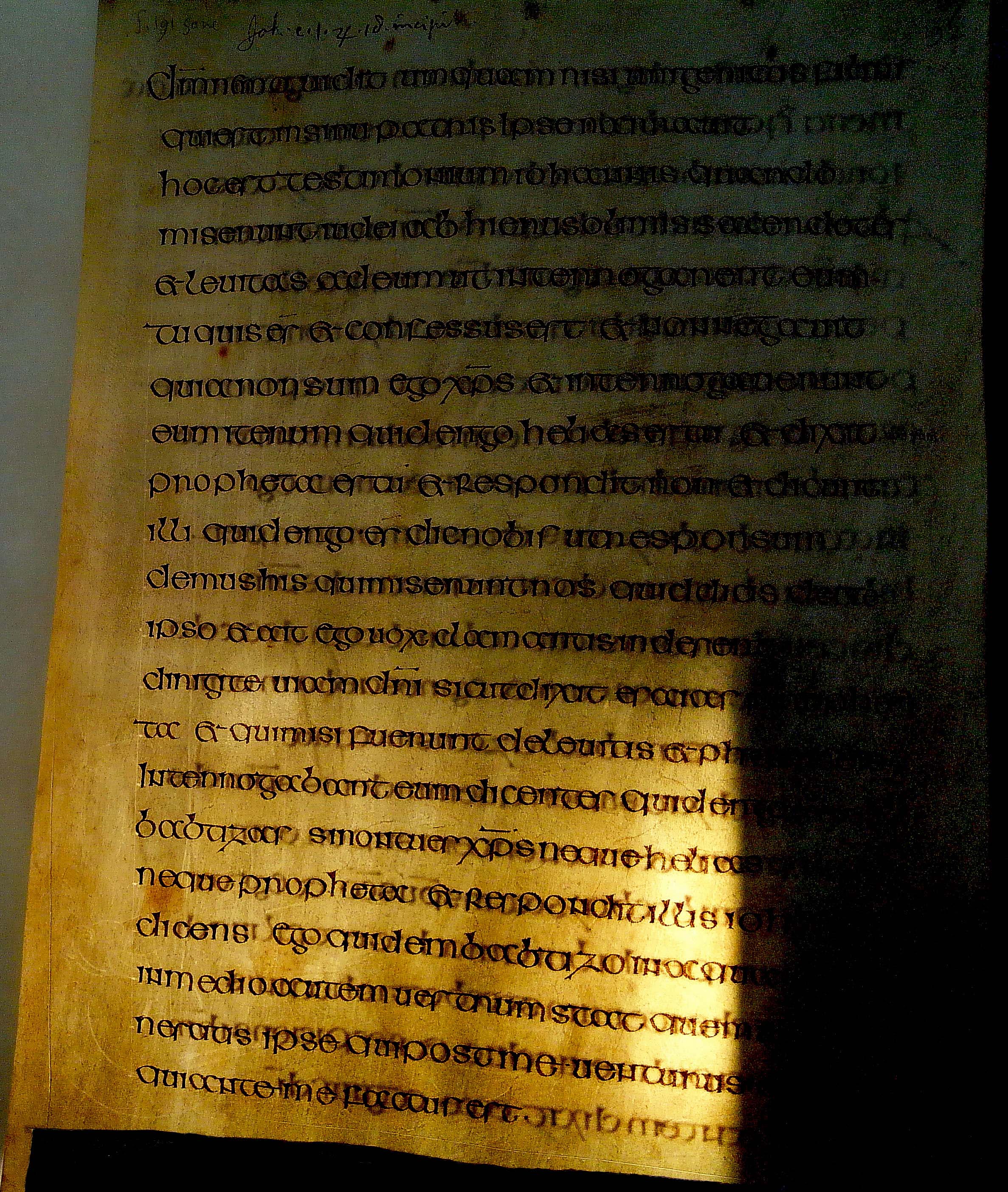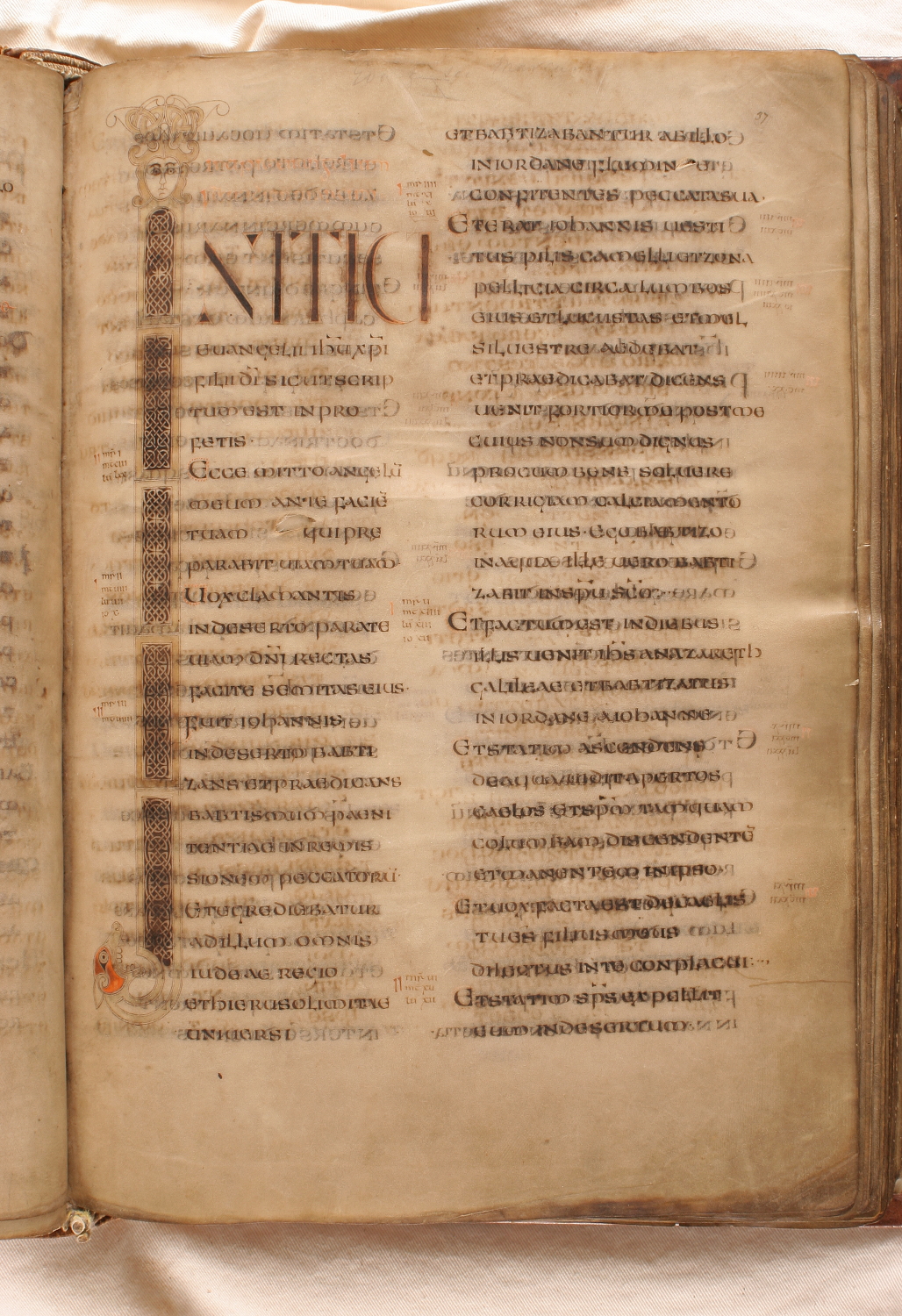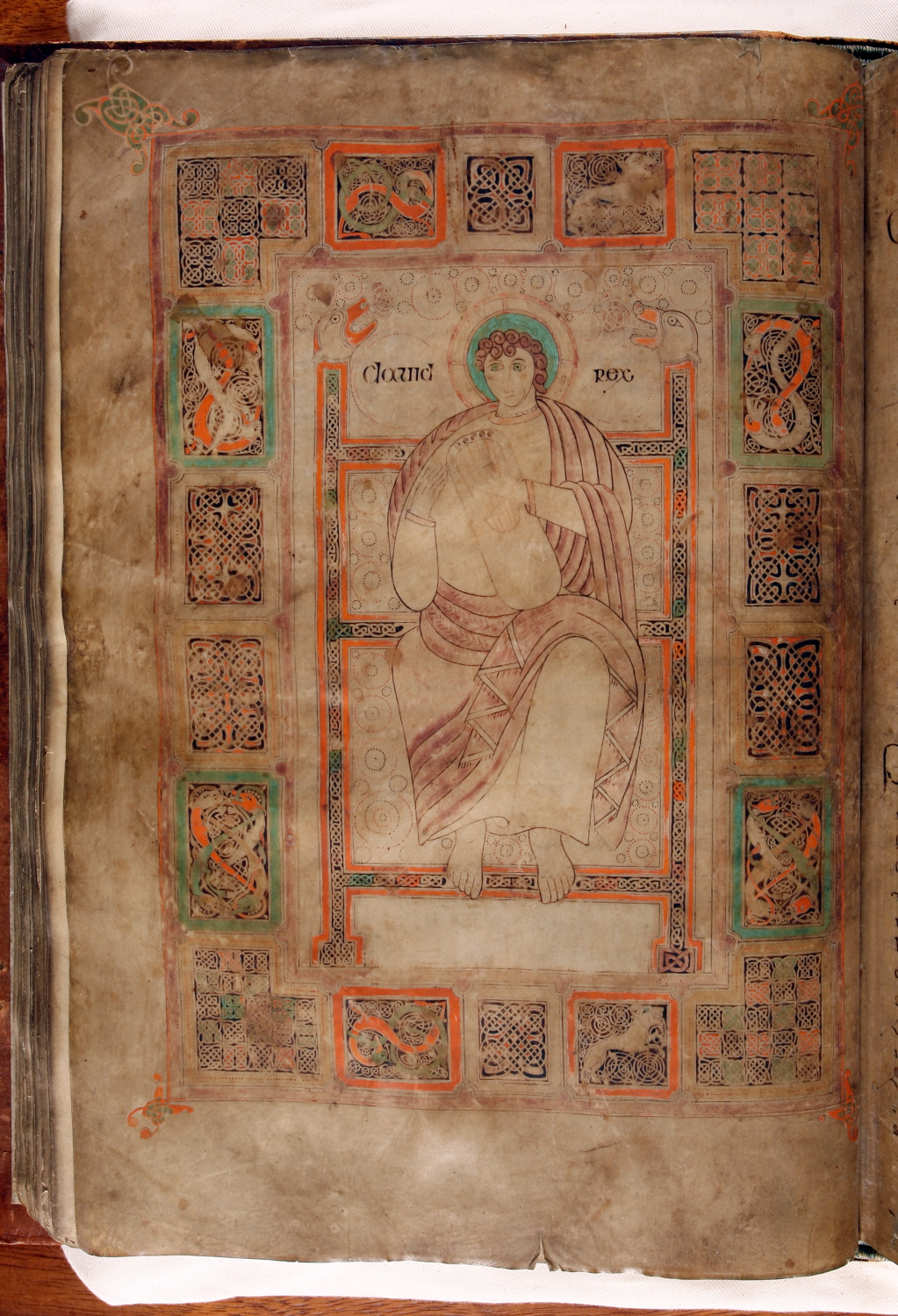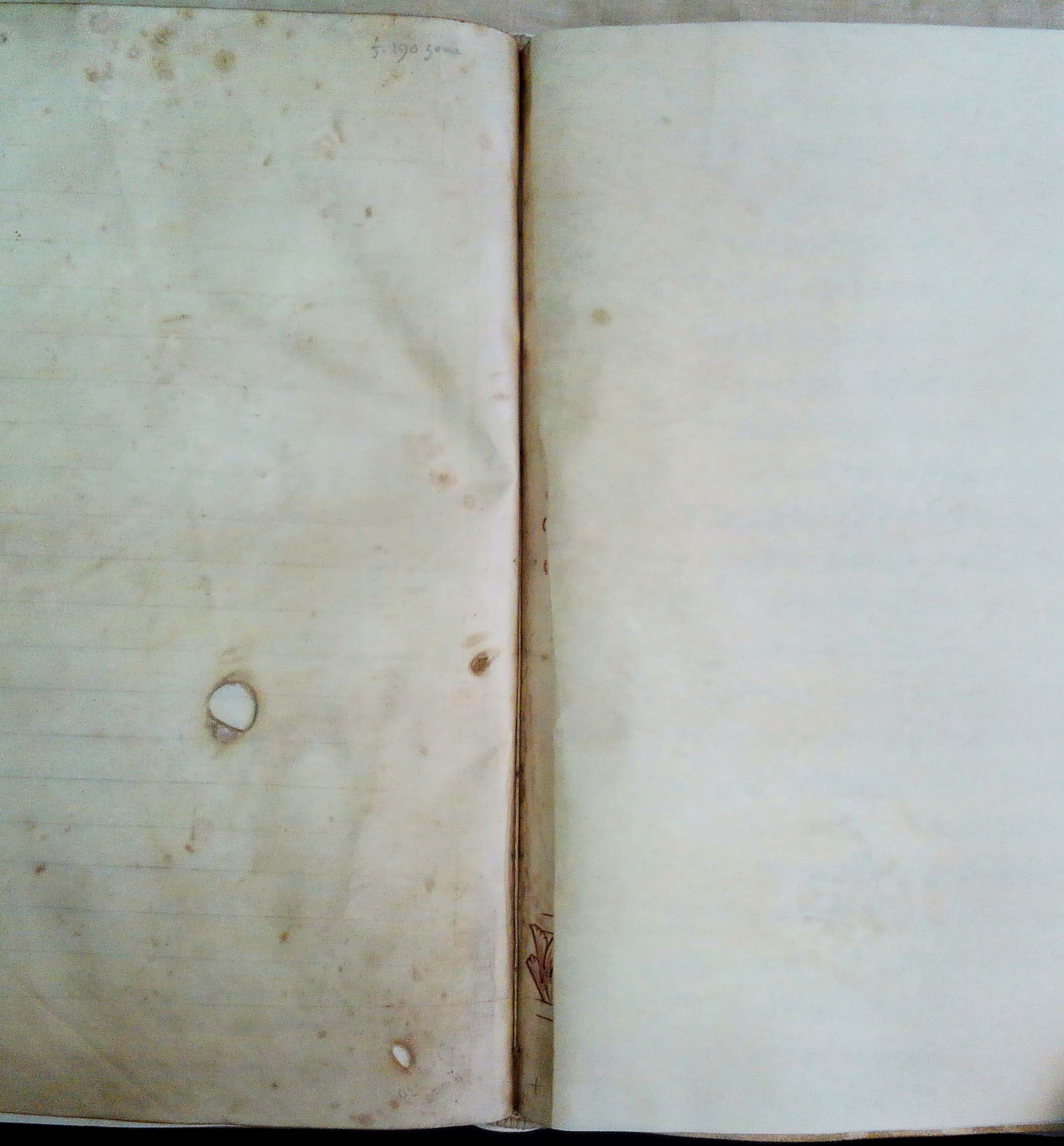
Absence as Evidence: Recovering the Losses in an Eighth-century Gospel Book
Guest post by Dr Eleanor Jackson
“Noli me tangere” (do not touch me, John 20:17), reads the final line of the endmost surviving page of Cambridge University, MS Kk.1.24—a poignant accident in a manuscript that has suffered a long history of heavy and destructive handling. Kk.1.24 is an Insular gospel book from the eighth century, probably made in Northumbria given its similarities with Northumbrian manuscripts such as the more famous Lindisfarne Gospels (British Library, Cotton MS Nero D. IV). But unlike its splendidly intact cousin, Kk.1.24 has been reduced to only mutilated fragments of the gospels of Luke and John. A previous blog post already discussed what survives of this manuscript, but there is also much to be learned from what doesn’t survive. Absence is itself a form of evidence, and the absences in this manuscript can help to reveal its story.
One of the manuscript’s most striking absences is the loss of its decorative scheme. Insular gospel books are renowned for their artistic brilliance, but aside from a few flourishes and dots on minor initials, there is no decoration left in Kk.1.24. Yet there are still clues that allow us to reconstruct what was lost. The most evocative evidence is on fol. 192r, which begins with the text of John 1:18. The first seventeen verses of the Gospel of John must have occupied the previous leaf, fol. 191, but this has been cut out. This is particularly frustrating because on the first leaf of each gospel, the opening letters (the initials) are usually enlarged and decorated, and sometimes accompanied with display script, a frame and other artistic elements. But despite this loss, careful examination reveals the lingering ghost of the missing initials—it is just possible to make out the faint impression on fol. 192r of the decoration that once stood on the neighbouring leaf. Fol. 192r must have lain beneath the lost leaf when the artist/scribe firmly drew the decorated initial, so that the drawing left its imprint on the layer of parchment below. The resulting impression not only gives us a glimpse of what the lost initial looked like, but it also tells us about the manuscript’s sequence of production—clearly the pieces of parchment were all gathered together into their final structure before the drawing and writing were done.
 Cambridge University Library, MS Kk.1.24, fol. 192r. Impression of lost initial.
Cambridge University Library, MS Kk.1.24, fol. 192r. Impression of lost initial.
The preserved impression shows that the lost initial was the height of the entire page. The tall ‘I’ of ‘In principio’ (the opening words of John’s gospel in Latin) appears to have been surmounted by a knot of interlace and to have curved backward at the base, ending in a dragon-like head that turns with open jaws and an extended tongue towards the letter. Originally this lost initial must have looked much like that on fol. 37r of the gospel book Durham Cathedral Library, MS A. II. 16, which closely parallels both the general design of the Kk.1.24 initial and the unusual spiral feature at the back of the beast’s head. Otherwise, with its broad and clearly delineated muzzle, rounded features, gently parted jaws and small high-set eyes, the dragon-head in Kk.1.24 is closer to the creatures in the Durham Cassiodorus (Durham Cathedral Library, MS B. II. 30), especially those on the terminals to King David’s throne on fol. 81v. These manuscripts also share other features with Kk.1.24. For example, A. II. 16 is marked up for liturgical use in a similar way with superscript ‘I’s and ‘C’s to mark the words spoken by Christ and by a narrator (see previous post). Further, the renowned palaeographer E. A. Lowe considered the script of the Durham Cassiodorus to be the closest comparison to that of Kk.1.24. While we do not know exactly where they were made, both manuscripts are firmly associated with eighth-century Northumbria so that these similarities further situate our manuscript in this context.
 Durham Cathedral Library, MS A. II. 16, fol. 37r. Reproduced by kind permission of the Chapter of Durham Cathedral.
Durham Cathedral Library, MS A. II. 16, fol. 37r. Reproduced by kind permission of the Chapter of Durham Cathedral.
 Durham Cathedral Library, MS B. II. 30, fol. 81v. Reproduced by kind permission of the Chapter of Durham Cathedral.
Durham Cathedral Library, MS B. II. 30, fol. 81v. Reproduced by kind permission of the Chapter of Durham Cathedral.
Another trace of drawing also survives in Kk.1.24, giving us additional insight into the manuscript’s lost decorative scheme. Just before the impressed initial on fol. 192r, on the narrow stub of parchment where fol. 190 has been cut out, there are the remains of plant motifs drawn in red ink, one at the bottom of the page and another just over half-way up. Clearly this was once another decorated page. At this point in a gospel book, between the end of the Gospel of Luke and the beginning of the Gospel of John, it is usual to find a full-page evangelist portrait of John introducing his gospel text. Yet since these foliate motifs look like nothing that was produced in eighth-century Northumbria, they cannot have been part of an original evangelist portrait. So what are they?
 Cambridge University Library, MS Kk.1.24, fol. 189v and the stub of the lost fol. 190r. Remains of decoration.
Cambridge University Library, MS Kk.1.24, fol. 189v and the stub of the lost fol. 190r. Remains of decoration.
These drawings look like simpler line-drawn versions of a type of architectural frame with foliate bases and capitals that was sometimes used in Anglo-Saxon manuscripts of the tenth century, for example the Benedictional of St Æthelwold, fol. 56v (BL, MS Add. 49598), and the Trinity Gospels, fol. 17r (Cambridge, Trinity College, MS B. 10. 4). Further, the leaf with the foliate drawings in Kk.1.24 is one half of a bifolium that is separate from the original structure of the manuscript (along with its conjugate, the blank leaf fol. 189). We know that Anglo-Saxon artists sometimes updated old gospel books by adding new evangelist portraits alongside the originals, as in British Library Add. 40618, and Royal MS I. E. vi. And we know that Kk.1.24 was owned and treasured by the community of Ely Abbey in the tenth century, because they added texts about the abbey’s estates to the final leaf (now divided in two and separated from the rest of the manuscript in the Sloane and Cotton collections in the British Library), a practice that indicates that the manuscript was considered the safest and most sacred place to preserve the community’s most important documents. This evidence all adds up to suggest that the lost leaf with the plant decoration most likely contained an additional evangelist portrait created by tenth-century Anglo-Saxon artists, and probably intended as a pious renovation of the cherished manuscript.
From these traces of lost decoration, it is therefore possible to reconstruct two phases of decoration in this fragmented gospel book. The original phase, executed in eighth-century Northumbria, consisted of elaborate decorated initials to each gospel. It possibly also included evangelist portraits since there are severed stubs at the beginning of both surviving gospels that could have contained miniatures (the lost leaves fols 121 and 188). A second phase probably took place in tenth-century Ely, which most likely involved adding new evangelist portraits to each of the gospels as well as the estate documents at the end of the manuscript. This reveals a story of the continuing use and developing significance of the manuscript over at least two centuries. Both phases were then almost entirely obliterated in the early modern period when someone systematically went through the manuscript cutting out every decorated page. Such destruction reminds us of the staggering losses of cultural achievement that have been suffered throughout history. Yet Kk.1.24 demonstrates that despite all, with a little detective work it is possible to catch a flash of former glory in even the most unpromising of places.
***
If you are interested in more digitised Anglo-Saxon manuscripts, keep an eye on the Durham Priory Library Recreated digitisation project. We are very excited to see the Durham Cassiodorus online for the first time, and we are promised more to come!
Bibliography
George Henderson, Losses and Lacunae in Early Insular Art, The Third G. N. Garmonsway Lecture Memorial Lecture delivered on 9 May 1975 in the University of York, University of York Medieval Monograph Series 3 (York: University of York, 1982).
Elias A. Lowe, Codices Latini Antiquiores: A Palaeographical Guide to the Latin MSS. prior to the IXth Century, Part II: Great Britain and Ireland (2nd edn., Oxford: Clarendon, 1972), 138.
Patrick McGurk, Latin Gospel Books from A.D. 400 to A.D. 800, Publications de Scriptorium 5 (Paris and Brussels: Aux Éditions “Érasme”; Anvers and Amsterdam: Standaard-Boekhandel, 1961).

This manuscript was produced in Durham around 1250 AD. The purpose was to provide an antique seeming vehicle to legitimise Ely Abbey’s land holdings, as per the text on the end paper. The idea that people would deface a centuries old sacred manuscript either with pictures or land charters is risible. Apart from the fact that parchment in daily use for those centuries would be virtually impossible to write on with medieval techniques. Or for that matter, modern ones.
Dear Mr Harper,
Since Dr Jackson has now left the University Library for the position of Curator of Illuminated Manuscripts at the British Library, please permit me to respond to your comments:
Contrary to your claim about the date of the production of the manuscript, all of the palaeographical evidence points to its copying during the 8th century (see: E.A. Lowe, Codices Latini Antiquiores. Part II: Great Britain and Ireland (1935), no. 138). There is no evidence in the manuscript itself, or in any known documentary sources, to locate its production specifically in Durham, however Lowe concluded: ‘Written in England, probably in a Northumbrian centre, to judge by the resemblance between the compressed script of this MS. and the script of the Durham Cassiodorus (No. 152)’ (the Durham Cassiodorus = Durham Cathedral Library, MS B.II.30, also written ‘in a Northumbrian centre’, though not necessarily Durham).
The script of MS Kk.1.24 is an Anglo-Saxon majuscule, found in many manuscripts of this period, with a number of letter-forms taken from uncial script. The technique of ornamenting minor initials with sequences of coloured dots is also common among books produced around this time: see, for example, the Lindisfarne Gospels (London, British Library, Cotton MS Nero D IV) and the Moore Bede (Cambridge, University Library, MS Kk.5.16), both of which have been digitised and are available to view online, and both of which emanated from centres in the north-east.
It is true that monastic scribes did (particularly after the Norman Conquest) create documents, sometimes using archaizing scripts, in order to give legal form to rights, privileges and possessions that had previously been enjoyed through custom; both R.W. Southern (‘Presidential Address: Aspects of the European Tradition of Historical Writing: 4. The Sense of the Past’, Transactions of the Royal Historical Society, 23 (1973), pp. 243-263) and M.T. Clanchy (From Memory to Written Record: England 1066-1307, 2nd edn. (Oxford: Blackwell, 1993) deal with this issue, as I recall. However, the palaeographical and decorative evidence proves that this is not the case with MS Kk.1.24. I am unclear, furthermore, quite why scribes at Durham would be preoccupied with the landholdings of Ely Abbey, an entirely separate foundation.
The copying of charters and other such documents into the spaces in a manuscript containing religious texts would not have been considered defacement; nor indeed would the supplementing of the text at a later date with images. There are plentiful examples of both practices. For the former, which I hope will suffice for now, I direct your attention to one of our other manuscripts, the Book of Deer (MS Ii.6.32), which amongst the Gospels contains copies of texts, added by one or more later hands, comprising an account of the foundation of Deer by Sts Columba and Drostan, land grants to the house, and a Latin brieve issued by David I in favour of the “clerics of Deer”. These documents were lent legitimacy and verity by virtue of their proximity to the sacred texts. Furthermore, copies of the Scriptures, by virtue of their status as the word of God would have been afforded especial protection in the medieval period. They were thus a safe and secure place for important information to be stored (however prosaic and inappropriate that information might seem to modern eyes).
I am afraid that I do not understand your point about writing on parchment, however I need perhaps only point to the very many examples of the use of parchment as a writing support at least as early as the late antique period and throughout the medieval period and into the sixteenth century. Medieval scribes would have had no difficulty writing on parchment, even if that parchment had been made some centuries previously, and had the tools to do so. There are furthermore practising scribes today who have been able to reconstruct the writing materials used by their medieval predecessors and write on parchment themselves.
I hope this clarifies the matter and answers your queries.
Sincerely,
Dr James Freeman
Medieval Manuscripts Specialist